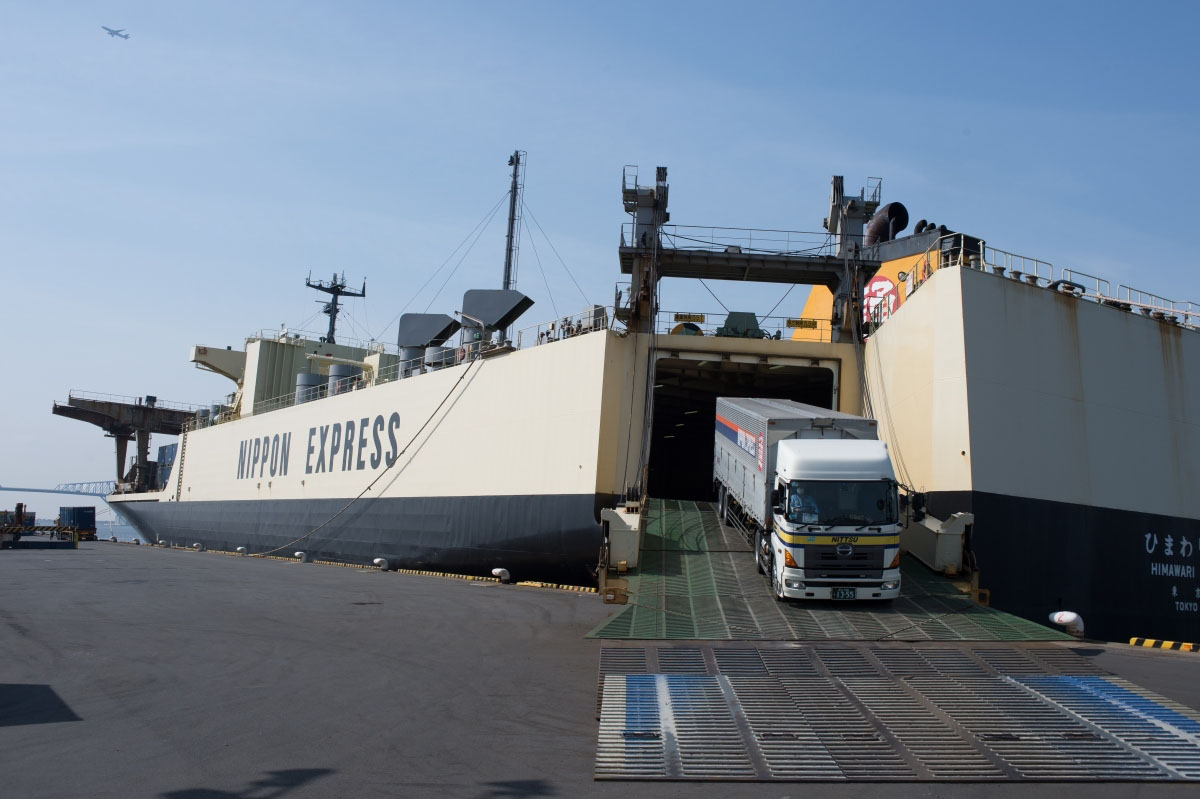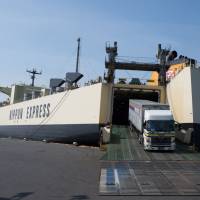Dear Alice,
I spotted what I think must be a very unusual ship while riding my bike along the Tokyo waterfront near Wakasu Park. It was like a ferry, in that trucks were driving up a ramp right into the boat. But at the same time a crane was loading shipping containers onto the deck, like a cargo ship. The ship was sizeable but didn't seem big enough for cross-ocean travel. So where the heck does it go? And what the heck does it carry? Are goods transported within Japan by ship? That would make sense, when you consider this country's geography, but I admit I've never thought about it before.
Richard M., Urayasu, Chiba Prefecture
Dear Richard,
It took a little sleuthing to find out what ships call at Wakasu, and then to narrow the list down to a vessel meeting that description, but I can now say definitively that the ship you saw was the Himawari 1, which travels twice a week between Tokyo and Hokkaido.
On a typical voyage, the ship departs Tokyo at 9 p.m. with a mixed load of daily necessities, beverages and old newspapers bound for recycling. It arrives two days later in the port of Tomakomai. By evening, it's ready to head back to Tokyo with a new cargo of agricultural goods and paper products made from the recycled newspapers.
This kind of shipping, in which cargo is moved by water without crossing a major ocean, is called "coastal shipping" in English and "naikō kaiun" in Japanese. To find out more, I paid a visit to the Japan Federation of Coastal Shipping Associations (JFCSA) headquarters in Tokyo, where I learned that coastal shipping accounts for about 40 percent of Japan's domestic cargo transportation. That's on what's called a "tonnage kilometer" basis, which means you factor in both weight and distance. About 80 percent of the raw materials used by Japanese industry, including petroleum products, iron, steel, cement and limestone are transported by coastal shipping, according to JFCSA.
Japan's geography does indeed seem to favor coastal shipping, since it is long and narrow and surrounded by ocean. The center of the country is mountainous, which makes land travel difficult, and most of the population lives near coastal ports. During the Edo Period (1603-1868), the Tokugawa shogunate set up sophisticated systems for moving large quantities of goods by boats that sailed up and down the coasts. But in the 19th and 20th centuries, coastal shipping gradually lost ground to railroads and trucks.
Currently, more goods are moved within Japan by trucks than any other method, accounting for about 55 percent of shipments on that same tonnage kilometer basis, and more when calculated in other ways. Shipments by rail and air make up only a small percentage of shipments within Japan. Trucking is convenient because goods can be delivered door-to-door, without the need to load and unload at intermediate points along the way. But Japan's highways are congested and the trucking industry suffers from a severe shortage of drivers, as experienced drivers age and young people shun the work as too difficult.
To help ensure the smooth movement of goods, the government is now encouraging a "modal shift" to move a portion of the freight carried by trucks to coastal shipping. That would not only ease the pressure on the trucking industry, but would also help the country meet its goals for reduction of carbon-dioxide emissions, because coastal shipping is more energy efficient. Moving one ton of freight by sea creates one-fifth the CO₂ emissions produced by moving the same weight by truck.
But let me steer us back to the specific ship you saw, which is operated by Nippon Express, a major player in domestic and international logistics. Shigenori Makino of the company's coastal shipping group confirmed that the Himawari 1 is an unusual combination of a container ship and what's called a "roll on/roll off" (RORO) ship, or roro-sen in Japanese. RORO ships are designed to carry cargo vehicles that are driven on and off the ship. This is in contrast to lift-on/lift-off (LOLO) vessels, which use a crane to load and unload cargo. Small ferries that operate across short distances also have built-in ramps, but the term RORO is generally reserved for larger, ocean-going vessels.
"Himawari 1 can accommodate 50 12-meter truck trailers in a section we call the 'chassis hold,' but it can also carry 400 shipping containers in the container holds toward the front of the ship," Makino told me. The other special feature that distinguishes this ship, he said, is that it has an onboard gantry crane. "Normally, containers are loaded on and off ships with cranes that are built as part of the port facilities. But because the Himawari 1 has its own crane on board, it has more flexibility in loading and unloading and can call at ports that don't have cranes."
This flexibility was a saving grace immediately after the Great East Japan Earthquake in March 2011, when the Himawari 1 was sent to Tohoku on a special relief mission to carry emergency supplies of heating fuel to the disaster area. At the time, it was difficult for trucks to reach the area because of massive damage to the road systems, and it was unclear what damage the facilities in the port of Sendai had suffered.
"There were many lessons learned as a result of the Great East Japan Earthquake, but one of those was the importance of maintaining a healthy coastal shipping network so that goods can be moved by sea when a disaster interrupts other modes of transportation," Hideo Fujii of the JFCSA told me. "We in the industry are preparing for future disasters, and will work with national and local governments to ensure that food, fuel and supplies can be transported quickly and safely to affected areas."




















With your current subscription plan you can comment on stories. However, before writing your first comment, please create a display name in the Profile section of your subscriber account page.